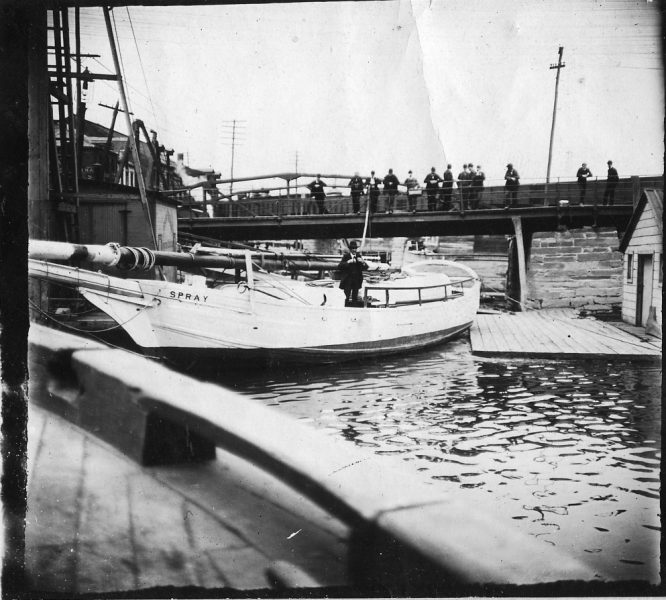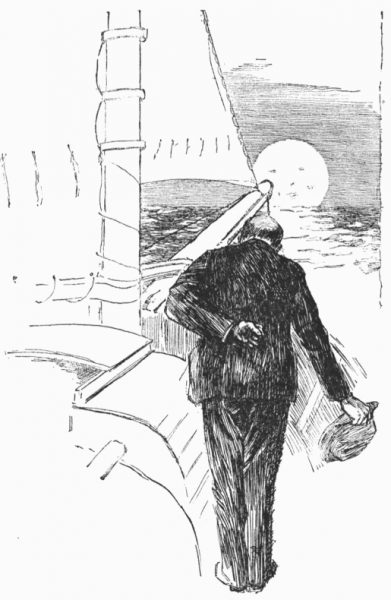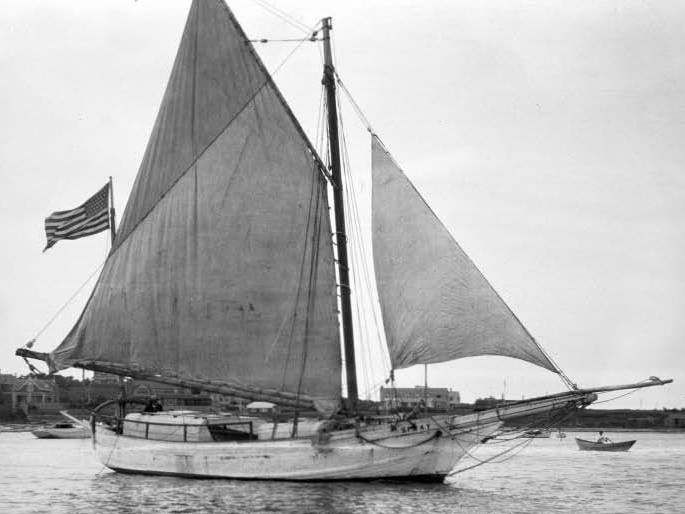
Read of the Week: ‘Sailing Alone Around the World’
On November 14, 1909, Captain Joshua Slocum set sail from Martha’s Vineyard, Massachusetts, for the Caribbean aboard his 36-ft cutter Spray. It was one of Slocum’s “typical winter voyages,” and practically a daysail for the man who, 20 years earlier, had completed the first-ever singlehanded circumnavigation of the world.
Slocum went on to pen the best-seller Sailing Alone Around the World, a seminal book that earned him critical and financial success. “The book rapidly became a bestseller and was reprinted many times,” says the introduction of SAATW. “Some persons living today may remember when it was required reading in public schools. For it is more than a record of an epic voyage: It is a masterpiece of vivid story telling. The pace is as swift as Spray herself.”
Joshua Slocum never arrived in the Caribbean in 1909. In July 1910, Slocum’s wife Henrietta told local reporters that she believed the famed captain had been lost at sea. Slocum was declared legally dead in 1924. He was 65 upon his departure.
The legacy that Joshua Slocum left behind is unparalleled in the sailing universe, in both his feat as a mariner and his lasting prose as a writer. Sailing Alone Around the World continues to inspire sailors of all stripes.

“Sailing Alone won [Slocum] widespread fame in the English-speaking world,” says Wikipedia. “He was one of eight invited speakers at a dinner in honor of Mark Twain in December 1900.”
“I made for the cove, a lovely branch of Gloucester’s fine harbor. The bay was feather-white as my little vessel tore in, smothered in foam. It was my first experience of coming into port alone, with a craft of any size, and in among shipping. I hardly know how a calamity was averted, but with my heart in my mouth, almost, I let go the wheel, stepped quickly forward, and downed the jib. The sloop naturally rounded in the wind, and just ranging ahead, laid her cheek against a mooring-pile at the windward corner of the wharf, so quietly, after all, that she would not have broken an egg.
“Very leisurely, I passed a rope around the post, and she was moored. Then a cheer went up from the little crowd on the wharf. ‘You couldn’t ‘a’ done it better.’ I said nothing. Had I uttered a word it surely would have betrayed me, for I was still quite nervous and short of breath.”
I don’t know if this quote made me take extra care and pride in smooth, effortless dockings, or if it reminded me that I already had taken such pride. I’d been nervous, too, the first few times docking bigger boats by myself and under sail, but then did it so often that it became sport, even art.

I realize now that it is Slocum’s humble and earnest assessments of himself that are so appealing. We can, without hyperbole, call Josh Slocum one of the greatest sailors to ever sail, but he talks about the process of sailing in a way that almost any sailor can relate to.
“The voyage is invested with a deceptive air of casualness that often becomes downright comical,” the introduction to SAATW reads. “One reads with a chuckle how the captain ‘lamented the day I allowed on board the goat that ate my chart.'”
Here’s my favorite touch of dry wit from Slocum: “My dory was leaking fast, and by the time I had rowed far enough to drop the anchor, she was full to the gunwale and sinking… I grasped her gunwale and held on as she turned bottom up, for I suddenly remembered that I could not swim.”
As funny as SAATW is, it is also deeply reflective — one could say that it delves into the psychology of extreme isolation.
“The waves rose high, but I had a good ship. Still, in the dismal fog I felt myself drifting into loneliness, an insect on a straw in the midst of the elements. I lashed the helm, and my vessel held her course, and while she sailed I slept.
“During these days a feeling of awe crept over me. My memory worked with startling power. The ominous, the insignificant, the great, the small, the wonderful, the commonplace — all appeared before my mental vision in magical succession. Pages of my history were recalled which had been so long forgotten that they seemed to belong to a previous existence.
“I heard all the voices of the past laughing, crying, telling what I had heard them tell in many corners of the earth.”

Captain Joshua Slocum was such a paradigm-shattering sailor that another paradigm-shattering sailor, Bernard Moitessier, named his boat Joshua.
Both Slocum and Moitessier wrote as much about the mind as they did about sailing. In a 1981 interview with Latitude 38, Moitessier famously said of his round-and-round-the-world voyage during the 1968 Golden Globe race, “I didn’t know I was going to fight against the ‘dragon,’ which is the second aspect of the trip, the spiritual part. The physical part is that you must be very careful and be as good a sailor as you can be.”
Though they are inextricably tied to sailing (and we’re calling them “sailing books”), I’d like to think that both SAATW and The Long Way sit on the esteemed shelves in the library of great books written by great writers.
Moitessier was such a paradigm-shattering sailor that he inspired paradigm-shattering sailor Liz Clark. In the introduction to her book, Swell, Clark writes, “My hope is that by sharing both my inner and outer voyages on these pages, you might be inspired to listen closer [to] the yearnings of your heart, face your inner dragons, and decide to choose love over fear, again and again.”

You can find Swell, Sailing Alone Around the World, and The Long Way — along with hundreds of other titles — at our online bookstore: www.bookshop.org/shop/Latitude38. We know you have a lot of options when doing your Christmas shopping, and we thank you for supporting independent bookstores, and supporting Latitude 38.
PS: Though we’d love it if you shopped from our bookstore, Sailing Alone Around the World is available in its entirety and complete with illustrations, online.

For myself, his earlier book,”Voyage of the Liberdade”, is even more compelling. Building a seaworthy vessel for his family in the Brazilian jungle and sailing it back to the USA was an even greater feat than his voyage around the world.
I built a replica of the Spray with my father in NJ in the mid 1980’s, but he never finished it after getting the hull built. Divorce goes with boat building, I guess.
Prior to that, we traveled to Maine to sail on a replica of Spray made by Ed Davis in Bar Harbor.
Real sailing in history, Ed’s Spray was as close to original as you could get, if you ignored the diesel engine.
I spent time in the Fairhaven, Massachusetts, library doing research on the Spray. In their vault, I found an old newspaper article that said, “The Spray was run down by a steamer in the night.” They actually had the old newspaper clippings in a Vault. Slocum was known not to run with lights at night and a steamer had damage at the level that would indicate the Spray. Go to Fairhaven and read it for yourself. In this day in age, I would have a picture of the newspaper clipping.
None of the historians that I know of read that clipping, and I do not know if any had been to Fairhaven Library.
May I offer a recommendation for a book to add to your Lat-38 ‘readers’ suggested books…
The book is “Cochrane: The Real Master and Commander.” by David Cordingly ‘Bloomsbury Publishers” 2007
The book is the authorized biography of Thomas Cochrane who lived during the Napoleanic Age of Fighting Sail, (1775-1860) whose real life became the primary source for the fictional life of Jack Aubrey in the series written by Patrick O’Brien.
This biography is well-written and reads easily , not in anyway dry or academic; and it brings back all the memories of the various escapades of the fictional naval officer, sailor and adventurer.
Arguably the best such series ever written…and this biography makes Aubrey seem even more alive.